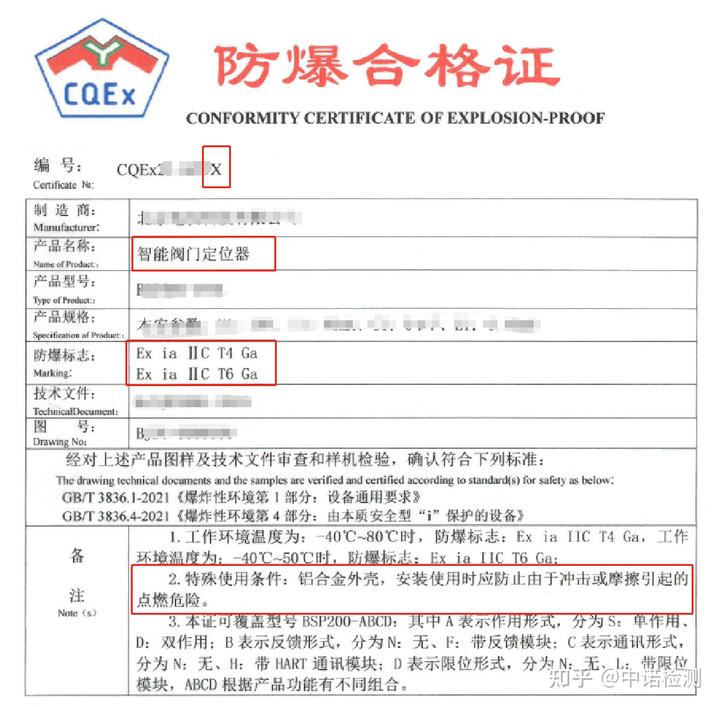
由于塑料外壳和塑料材质的不稳定性和静电电荷聚集的危险,大部分的防爆产品基本都采取金属外壳或者金属部件,以降低爆炸风险的发生率。但是金属外壳和金属部件的应用也要考虑金属的特性情况。比如铝、镁等活跃性较高的就不适合直接用于外壳上。较常见的是铸铝、铸铁、铸钢、不锈钢等材质。在《GB/T 3836.1-2021爆炸性环境 第1部分:设备 通用要求》的第8章也有专门提出金属外壳和外壳的金属部件的基本要求。
8 金属外壳和外壳的金属部件
8.1 材料成分
在第24章要求的文件中应规定外壳或外壳部件的材料。
注1:文件不要求对材料的化学成分进行试验验证。
注2:施加于金属外壳的漆或涂层是外壳的非金属部件,GB/T 3836.7.4“外部非金属材料上的静电电荷”的要求适用。
注3:锌和含锌80%或更高的锌合金容易迅速劣化(特别是抗拉强度),尤其是在温暖潮湿的空气中。 锌也被认为比其他金属更有活性。 一些防爆型式不允许将锌用于外壳。
8.2 Ⅰ类设备
制造Ⅰ类EPL Ma级或Mb级设备外壳材料,总含量(质量分数)不应超过:
15%的铝、镁、钛和锆,其中镁、钛和锆不超过7.5%。
上述要求不适用于Ⅰ类携带式测量设备,但设备应按29.3e)的要求标志符号 "X",并在特殊使用条件中指明贮存、运输和使用过程中特别注意事项。
8.3 Ⅱ类设备
制造用于不同设备保护级别的Ⅱ类设备外壳材料,总含量(质量分数)不应超过:
对于EPL Ga:10%的铝、镁、钛和锆,其中镁、钛和锆不超过7.5%;
对于EPL Gb:7.5%的镁、钛和锆;
对于EPL Gc:除风扇、风扇罩和通风孔挡板应符合EPL Gb的要求外,无其他要求。
如果超过了上述EPL Ga或Gb级设备的材料成分限制,设备应按照29.3e)的规定标志"X",并且特殊使用条件应含有足够的信息,以保证用户能够确定设备是否适合在特定条件下使用,例如,防止由于冲击或摩擦引起的点燃危险。
8.4 Ⅲ类设备
制造用于不同设备保护级别的Ⅲ类设备外壳材料,总含量(质量分数)不应超过:
对于EPL Da:7.5%的镁、钛和锆;
对于EPL Db:7.5%的镁、钛和锆;
对于EPL Dc:除风扇、风扇罩和通风孔挡板应符合EPL Db的要求外,无其他要求。
如果超过了上述EPL Da或Db级设备的材料成分限制,设备应按照29.3e)的规定标志"X",并且特殊使用条件应含有足够的信息,以保证用户能够确定设备是否适合在特定条件下使用,例如,防止由于冲击或摩擦引起的点燃危险。
8.5 铜合金
如果拟用于含乙快的环境,设备外壳和用于外部安装的Ex元件外壳,如果由铜或铜合金制成,应符合下列要求:
涂锌、镍或其他涂层;或
合金中高铜含量不超过65%。
附录A规定的电缆引入装置、封堵件、螺纹式管接头和绝缘套管不视为是要求涂层或铜含量限制的外壳表面。
注:限制在乙快环境使用铜是由于可能在外表面形成能被摩擦或撞击点燃的乙炔化物。
从标准中规定我们可以总结出:
1、对于Ⅰ类EPL Ma、EPL Mb设备,外壳金属材质对铝的含量有明确的要求。并且含有铝金属的外壳的设备应按29.3e)的要求标志符号 "X",并在特殊使用条件中指明贮存、运输和使用过程中特别注意事项。
2、对于Ⅱ类EPL Ga设备,外壳金属材质对铝的含量有明确的要求。一般我们就不建议采用铝合金外壳了。如果客户产品采用的是铝合金外壳,必须提供金属外壳的材质报告,明确铝的含量。如果铝含量超出规定的限值,常见有两种解决办法。
(1)设备必须按照29.3e的要求标志符号“X”,并且特殊使用条件应含有足够的信息,以保证用户能够确定设备是否适合在特定条件下使用,例如,防止由于冲击或摩擦引起的点燃危险。

(2)降低设备保护级别,比如防爆标志从Ex ia IIC T4 Ga降为Ex ia IIC T4 Gb。
4、含有乙炔环境中使用铜或铜合金的要求。在GB/T 3836.1-2021和GB/T 3836.2-2021中分别对乙炔环境使用设备的金属外壳和外壳金属部件都做了具体的要求。但根据专用标准优先于通用标准的原则。合金中铜的含量是要求不超过60%的。
禁止任何平台抄袭和转载!